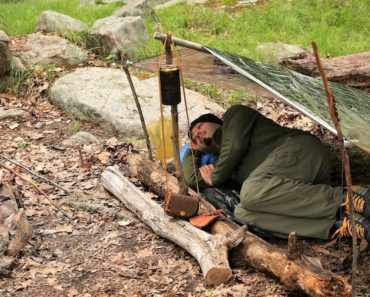Preppers spend a lot of time and money building bug-out bags, making a bug-out vehicle, and even making a yurt or other shelter to use when bugging out. Those projects can be fun and even worthwhile. But that doesn’t mean that they’ll ever be used for their intended purpose or even that they will be able to be used for that purpose.
Back when I got started in survival, everything was about bugging out. But that was in the 70s when we were still worried about the United States and the now-defunct Soviet Union going head to head with thermonuclear warheads. I lived in Colorado at the time, right up against the front range of the Rocky Mountains. As such, I had my bug-out plan in place, heading up into the mountains to survive the blast and going to a buddy’s cabin, where a small group of us were going to meet to survive together.
What made that a workable plan was that I lived literally on the front face of the first ridge, right beside a major road, so that I could make it to the back face of that ridge in 20 minutes. Even if others tried to bug out, I had a good chance of beating them to it, especially since I kept my survival gear in my car. All I had to do was jump in my car and beat the bow wave of people heading out of town, whether at school, work, or home. I even kept my car gassed up, so I wouldn’t run out of gas.
While that threat hasn’t entirely gone away, it’s largely been replaced by the risk of an attack by EMP. Considering that the Russians of today aren’t likely to blow up our cities, the prevailing philosophy has changed from bugging out to bugging in.
That’s a good change on many levels, not the least of which is that bugging out may not even be a viable option anyway, in most cases.
The Houston Example
We all talk about the problems with traffic jams and how they will make bugging out difficult, but do we understand what we’re saying? I just returned from the Thanksgiving weekend, and the traffic was horrible. And that was just from a holiday weekend, not anything serious.
Back in 2005, Houston, a metropolis of over seven million people, evacuated in anticipation of Hurricane Rita. The actual numbers of people who evacuated weren’t that high because not everyone obeyed the evacuation order. Still, the Houston Chronicle stated that 107 people died in the evacuation. Some sources put the number even higher.
So what went wrong with that mass bug out? We can point to many things, but it boils down to our highways not being built for that much traffic. That doesn’t just include the roadway itself. There are not enough service stations and enough gasoline to fuel that many cars.
The 100-mile long traffic jam heading out of Houston happened because cars broke down and ran out of gas. But it didn’t take long for there to be any gas for the evacuees to buy, leaving them stranded without shelter, either on the road or in overcrowded service stations where gas had run out, and food was following suit.
That was just one city, bugging out for a hurricane that decided to change directions. Most people didn’t even reach any reasonable destination, due to the traffic. Instead, they ended up turning around and going back home; once it was clear that the hurricane was going elsewhere.
The Florida Example
What would have happened if things had gone differently and Hurricane Rita had smashed into Houston with the devastation of Hurricane Harvey? Where would all those people have gone? When Hurricane Irma was bearing down on Florida in 2017, the governor called for an evacuation of the entire state. The people displaced by that evacuation filled hotels and motels up to the northern border of Georgia.
This example shows another major problem with bugging out; there aren’t enough places for all those people to go. If one of us is planning on bugging out to a hotel somewhere, chances of actually getting a room in that hotel will be pretty slim unless we happen to own the hotel. Just about any other place, we could stay likely to be just as full, even unlikely places like good campsites in the woods.
I’ll have to say that we can’t even count on the property we own being left alone and available for us to bug out to. What makes any of us think that the cabin the woods we’ve prepared for a disaster will be empty, with all our supplies intact, when we get there? Unless it is extremely well secured, on the order of a control bunker for firing nuclear missiles, we’re likely to find that someone beat us to our cabin and broke in, taking what is ours.
So what do we do?
First, the current philosophy in the prepping and survival community of bugging in rather than bugging out makes sense for most of us in most situations. But as Hurricane Harvey and the Camp Fire proved to us, there are times when it is essential to bug out to ensure our survival. So we need to be prepared to bug out.
But those situations are very particular and considerably different than bugging out in a TEOTWAWKI event where society has broken down, the scenario that most preppers talk about. If things ever get that bad and we try to bug out, we’ll probably end up being on impassible roads, full of broken-down vehicles, with crowds of starving people who will try to take everything we have.
Assuming that we still need to be able to bug out, there are some things that we have to do to make it a possibility:
Be Prepared to Bug Out
Looking at the various bug-out situations that have happened in recent years, one thing that stands out is the need to be ready to bug out at a moment’s notice. This is especially true for natural or manufactured disasters like the Oroville, California dam being about to rupture. Things can go from normal to bug out in a matter of moments, which may very well include massive numbers of unprepared people bugging out.
When I say “prepared,” I’m not just talking about having a bug-out bag; but rather having everything packed that needs to go. Since we’re including natural disasters in this, that will most likely mean things other than survival gear, like family mementos and valuables. You won’t want to leave those behind. Ideally, all of this should be in your bug-out vehicle; but that’s not practical. Who wants to keep photo albums or their jewelry box in the truck? So instead, it needs to be stored where it can readily be grabbed and put in the bug-out vehicle in a matter of moments.
It also has to include everything you’ll need to have to get to safety. When figuring that out, assume that you won’t beat the traffic and that you’ll be stuck in it. How much fuel will you need for your vehicle then? How much food and water to see you through? Most preppers don’t have that fuel on hand, even though they know it will be scarce in a bug out.
It’s also a good idea to have a checklist posted in the garage, where it is easy to see when loading, to make sure that nothing gets left behind. Have someone responsible for checking things off the list as they are loaded, not when it is staged. Bringing it into the garage for loading isn’t worth an item if it doesn’t make it into the vehicle.
Bug Out Early
The only way to accomplish any bug out is to bug out early, beating the rush. As we’re talking about a developing situation, that’s rather tricky to accomplish. Chances are, it may not be apparent that it is necessary to bug out until things have developed to the point where everyone else is bugging out too. By then, you’ll end up in a traffic jam.
The only way to make sure that you beat the rush is to be willing to take the chance that you’re bugging out when it’s not necessary. That might result in many false alarms and “trial runs” that turn into nothing.
Of course, if you have a cabin in the woods, you can always turn those mistaken bug-out trips into a weekend getaway, even if they happen in the middle of the week. At least that way, the journey isn’t wasted.
Another option is to bug out early by moving out of town to wherever you would be bugging out too. That might take a bit of planning, as you might have to buy or build such a place and make any necessary job changes so that you can work from that location. Still, that’s the ultimate early bug out, making it possible to bug in and bug out simultaneously.
Have a Prepared and Stocked Destination
Speaking of which, I’m personally saddened by how few preppers have a prepared and stocked survival retreat. I understand the financial difficulty in buying a cabin in the woods; I can’t afford one either. But that doesn’t mean that I don’t have a cache of equipment and supplies set up where I’m planning on bugging out to so that I’ll be ready to survive when I get there.
Considering the shortage of available hotel space in a mass evacuation, I don’t count on that for housing. Instead, I plan on using a tent. Hopefully, I’ll be able to buy a travel trailer and park it permanently in my intended bug-out destination shortly. But even if I can’t, I will have a good tent for shelter when I get there.
Be Able to Travel Off-Road
Assuming that any of us don’t succeed in bugging out early, we’re going to have to be able to travel off-road. That doesn’t necessarily mean having the biggest, badest 4×4 truck out there. A four-wheel drive isn’t needed; what is required is ground clearance. Modifying the family sedan to have more ground clearance can often be enough to allow you to hop curbs and cross fields.
The real risk in going off-road is that there are very few places where you can drive off-road, where you won’t be moving on someone’s property. How do you think a farmer or rancher would react if you started tearing down fences and driving across their fields? Do you want to get into a shouting match with them? If you did, you’d be guilty of murder, not self-defense.
When I’m talking about going off-road, I’m talking about driving on the land between the highway and that farm or ranch land. There’s an easement, which is government property that you can drive on. The idea is to use that to get around traffic that’s stranded on the highway; then, once you get past it (if you ever do), you can return to the road.
The other way of going off-road is going on foot. That’s problematic for most of us for two reasons. The first is that our survival retreat is too far from home to walk, and the second is that we’re too out of shape to walk that far. Getting ready to go off-road and walk to a survival retreat in this way will take time and exercise and probably lose a bit of weight. Nevertheless, if we want to survive, that’s a project that’s well worth undertaking.
But What if You Don’t Bug Out Early?
All of that was dealing with bugging out early, but what if you don’t? After all, the idea of bugging out early directly contradicts the philosophy of bugging in as our first choice. So what do we do?
First of all, bugging out early really only works if you have someplace to go to. Ideally, that means a cabin in the woods or another such destination. If you don’t have that, then bugging out early only makes sense if you are trying to beat the destructive forces of a fire, hurricane, flood, or another disaster that is likely to destroy your home.
To get away from social unrest, the other sort of bugging out is more complicated and harder to anticipate. The chances are that you won’t be able to figure out when that is coming and beat the rush. But then, there probably won’t be a massive exodus in such a case. You’ll be bugging out more or less alone or in the midst of a much smaller group, perhaps a few thousand people at the most.
In such cases, you’re probably going to be best off waiting as long as you can so that others are off the roads. There will probably still be a lot of abandoned cars on the roads to deal with, and there’s a good chance that there will be criminal activity that you have to protect yourself from, but at least you won’t have the problem of being stuck in traffic.
You will still need to be sure that you have everything you need to see you through to your destination, especially gasoline. Don’t count on resupply along the road unless you have supply caches set up that you can use. Anyone who has supplies available will probably want more for them than you will be willing to give.





























